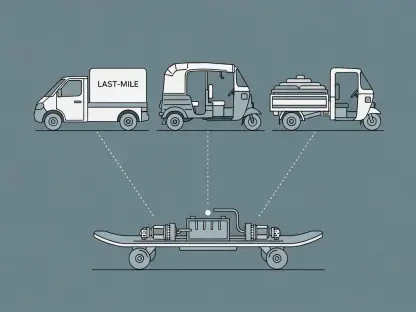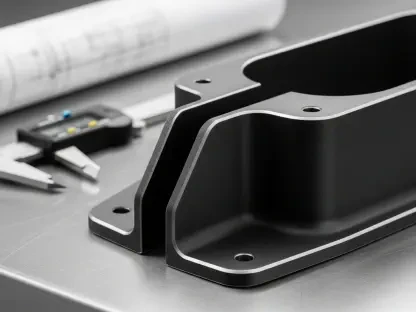Imagine a world where transport systems operate seamlessly without human intervention, slashing travel times, reducing accidents, and boosting economic output across multiple industries. The UK Government has taken a bold step toward this vision with a £36.5 million investment in connected and automated mobility (CAM) technologies. This substantial funding, part of the larger £150 million CAM Pathfinder program, seeks to establish the UK as a global frontrunner in transport innovation. By channeling resources into cutting-edge mobility solutions, the initiative not only aims to transform how goods and people move but also to catalyze significant economic growth. The focus extends beyond personal vehicles to high-impact sectors like logistics and aviation, promising widespread benefits. This strategic push reflects a commitment to integrating advanced technology into everyday systems, setting the stage for a revolution in mobility that could redefine industrial and commercial landscapes.
Driving Innovation Through Strategic Funding
New Funds to Propel Mobility Solutions
The announcement of £36.5 million in funding has introduced four pivotal funds—known as Mobilise, Demonstrate, Enable, and Feasibility Studies—designed to accelerate the development of automated mobility technologies. Unveiled at a notable event hosted by the University of Warwick, these funds are managed by Innovate UK and Zenzic, building on previous investments that bring the total CAM Pathfinder commitment to £58 million. The scope of these resources targets a diverse array of UK-based projects, spanning industries such as maritime, manufacturing, and aviation. This broad approach ensures that the benefits of automation are not confined to a single sector but are instead felt across various commercial arenas. By prioritizing projects with high potential for real-world application, the initiative seeks to create a robust foundation for scalable and sustainable innovation, positioning the UK to tackle modern transport challenges with advanced technological solutions.
Building on Past Successes for Future Growth
Complementing the newly launched funds, earlier programs like Enhancements and Feasibility Studies have already laid critical groundwork for CAM advancements, contributing to the cumulative investment. This continuity highlights a deliberate strategy to sustain momentum in the sector by learning from past efforts and refining approaches to maximize impact. The focus remains on fostering projects that promise not just technological breakthroughs but also tangible economic returns, with an emphasis on sectors poised for transformation through automation. Collaborative efforts between government bodies and private entities have been instrumental in identifying priority areas, ensuring that funding aligns with market needs. As these initiatives progress, they are expected to pave the way for commercial pilots in the near future, potentially setting benchmarks for global standards in automated mobility and reinforcing the UK’s competitive edge in this rapidly evolving field.
Economic and Industrial Transformation
Unlocking a Multi-Billion Pound Opportunity
The economic implications of CAM technologies are staggering, with industry projections from the SMMT estimating a potential £66 billion boost to the UK economy alongside the creation of over 12,000 jobs in vehicle manufacturing alone. This forecast underscores the transformative power of automation, not merely as a technological novelty but as a cornerstone for industrial growth. Former Minister of State for Industry, Rt Hon Sarah Jones MP, emphasized the government’s vision to harness this potential through strategic investments and supportive policies. Beyond funding, efforts to expedite regulatory frameworks for automated passenger services signal a proactive stance in adapting to emerging technologies. Drawing inspiration from successful models like California’s self-driving vehicle programs, the UK aims to roll out commercial pilots soon, ensuring that economic benefits are realized swiftly while maintaining safety and reliability standards.
Fostering Collaboration Across Sectors
A key pillar of the CAM Pathfinder program is the emphasis on collaboration among government, industry, and academic institutions to drive innovation. Program director at Zenzic, Mark Cracknell, highlighted the opportunities for businesses to integrate into the CAM supply chain, pointing to successful trials such as autonomous port handlers and self-driving pods as proof of concept. These real-world applications demonstrate how partnerships can translate cutting-edge ideas into practical solutions, benefiting both the economy and society at large. The call for wider business engagement reflects a shared understanding that sustained progress requires collective effort and diverse expertise. By aligning technological advancements with commercial viability, the program ensures that investments yield long-term gains, fostering an ecosystem where innovation thrives through shared goals and mutual support across various stakeholders.
Shaping a Forward-Looking Mobility Landscape
Regulatory Support as a Catalyst for Change
Beyond financial backing, the UK Government is prioritizing the creation of a regulatory environment conducive to CAM technologies, with the Transport Secretary actively working to streamline rules for automated services. This regulatory push is crucial for enabling rapid deployment of innovations, ensuring that technological advancements are not stifled by outdated policies. The goal is to balance safety with progress, allowing for swift integration of automated systems into public and commercial use. By looking to global examples where regulations have successfully supported self-driving technologies, the UK is crafting a framework that could serve as a model for others. This proactive approach in policy-making complements the £36.5 million investment, creating a holistic strategy that addresses both the technical and legal dimensions of adopting advanced mobility solutions at scale.
Prioritizing High-Impact Sectors for Maximum Benefit
The CAM Pathfinder program strategically focuses on sectors with high commercial potential, such as logistics and aviation, rather than niche applications, to ensure that investments deliver widespread benefits. This targeted direction reflects an understanding that the greatest returns come from transforming industries with significant economic footprints. By channeling resources into areas where automation can solve pressing challenges—like efficiency in supply chains or safety in transport hubs—the initiative maximizes its impact. The diversity of focus within the program also mitigates risks by spreading innovation across multiple fields, ensuring resilience and adaptability. As these efforts unfold, they set a precedent for how targeted funding and strategic prioritization can drive industrial evolution, positioning the UK to lead in the global race for automated mobility solutions through a well-rounded and forward-thinking approach.









